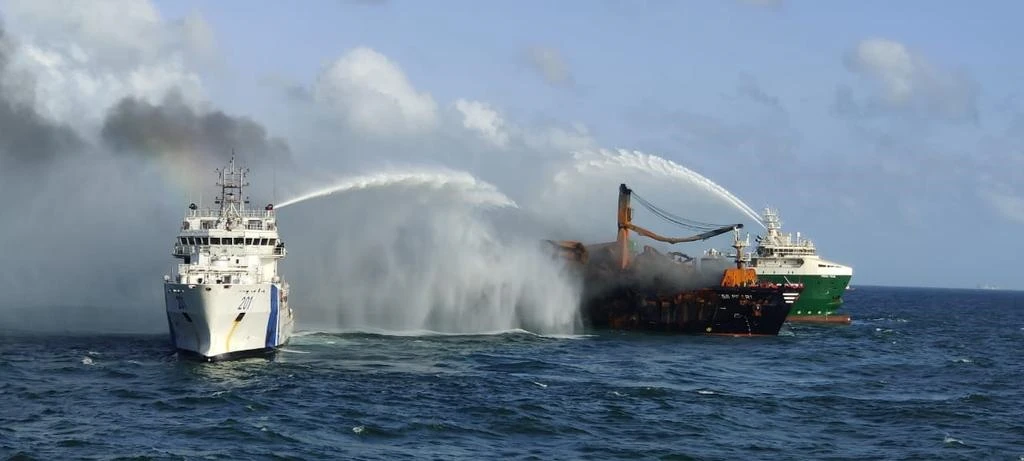Following the MV X-Press Pearl disaster, Sri Lanka today announced that Australia will assist the island nation in developing a comprehensive national maritime disaster preparedness mechanism.
The Ocean Affairs, Environment and Climate Change Division of the Lankan foreign ministry, together with the High Commission of Australia to Sri Lanka and the Maldives, held a multi-stakeholder meeting recently, to discuss international best practices, application of Systems Engineering model to work on the vision, mission and needs of Sri Lanka to establish a holistic and state-of-the-art Maritime Safety Authority.
The discussion was carried out to learn from the Australian experience on managing maritime disasters, in the aftermath of the MV-X Press Pearl, which is considered as the worst such disaster that ended up with polluting the ocean with a cargo containing large quantities of hazardous and noxious materials, chemicals and plastic nurdles.
On May 20 last year, Singapore-flagged MV X-Press Pearl caught fire off the coast of Sri Lanka leaving in its wake an environmental disaster that not only the island, but many littoral states of the Indian Ocean will have to live with for decades.
For days it stood burning off the coast of Sri Lanka, plumes of thick dark smoke that could be seen from miles away. The X-Press Pearl has now fallen silent, lying half sunken off the coast of Sri Lanka, its hull resting on the shallow ocean bed. Though the flames have now been doused, the problems have only just begun. While there have been shipwrecks before, Sri Lanka has never faced one with such poisonous cargo.
Chairing the meeting, Hasanthi Urugodawatte Dissanayake, the Acting Additional Secretary of Ocean Affairs, Environment and Climate Change, highlighted that if there is to be any upside from this incident, it would be by serving as a catalyst for building a more resilient system to prevent and respond to maritime disasters in the future.
This means prioritizing maritime emergency preparedness and management through development of a maritime disaster preparedness plan, strengthening the institutional basis for its implementation with adequate capacity building for the staff of relevant agencies.
High Commissioner of Australia to Sri Lanka David Holly stated that, to achieve this, a collective initiative by the Lankan government and its international friends and partners is needed. Holly stated that to ensure that support is delivered efficiently, a mechanism needs to be setup for accepting and facilitating international assistance to avoid overlaps and that key gaps are left unaddressed.
He emphasised that Australia's approach to maritime disaster preparedness may not be the best fit for Sri Lanka. However, the Australian government is ready to assist Colombo in building capacity to develop the most suitable system for Sri Lanka. The High Commissioner highlighted that having such a maritime disaster management entity in Sri Lanka could serve not only to address disasters in Sri Lankan waters and Sri Lanka's Search and Rescue region, but will act as a regional centre to complement other such entities in the Indian Ocean.
Sri Lanka's requirements for a Maritime Disaster Preparedness Mechanism/Authority from a defence viewpoint were explained by Lankan Navy's Chief of Staff Rear Admiral Y. N. Jayarathna while Sri Lanka’s marine environmental conservation requirements were explained by Chairperson Marine Environmental Protection Authority (MEPA) Dharshani Lahadhapura, Sri Lanka Port’s Authority Harbour Master Nirmal Silva delivered a brief presentation on the current wreck removal process of the MV-X Press Pearl.
Australian High Commission's Defence Adviser Captain Ian Cain presented a perceptive and informative presentation on the considerations for establishing a maritime disaster management authority in Sri Lanka, using the Systems Engineering approach, as considered by Australia in setting up of their own agency, the Australian Maritime Safety Authority (AMSA).
The Lankan foreign ministry had developed an initial working draft for a Maritime Disaster Preparedness Mechanism for Sri Lanka in September 2021 and had handed over the process to the Ministry of Ports and Shipping, which heads the committee established to develop the said mechanism. The Committee is currently in the process of fine-tuning the mechanism together with the relevant stakeholders.




















